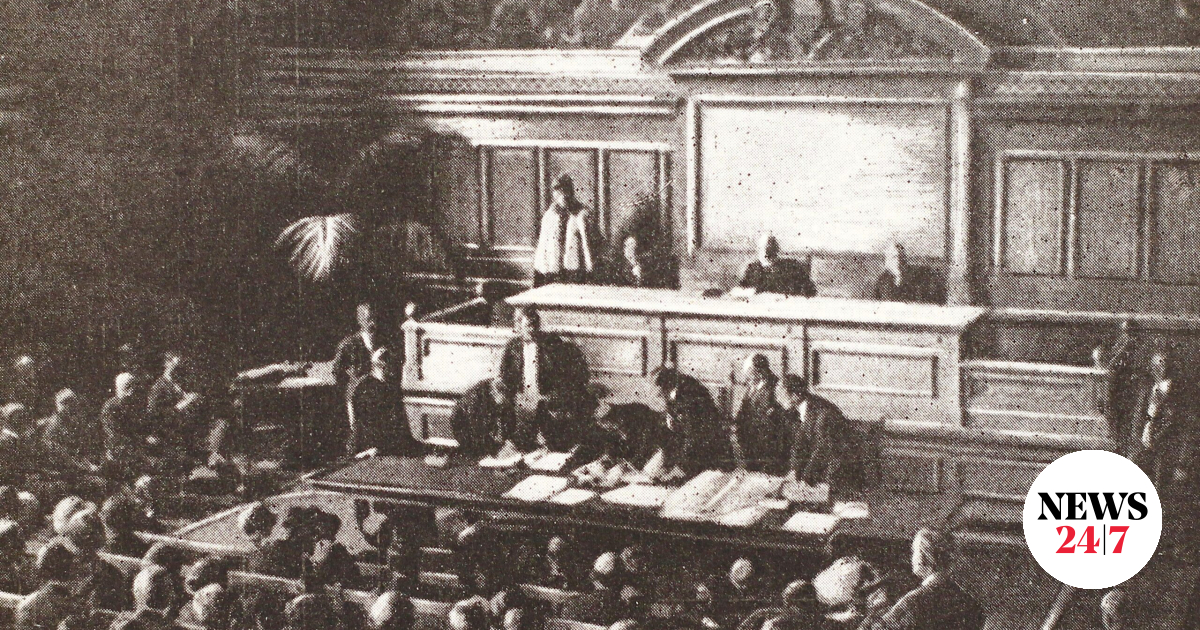
The Treaty of Lausanne It was a peace treaty that defined the borders of modern Turkey. Signed in Lausanne, Switzerland on July 24, 1923 by Greece, Turkey and other belligerent nations. World War I and Asia Minor Campaign (1919-1922) and participated in the Treaty of Sèvres, including the Soviet Union, which had not participated in the previous treaty.
The signed agreement was the result of the relevant conference between the above members which began on November 7, 1922.
Related article
The text of the treaty also included the Lausanne Convention, a shorter text and earlier signed on January 30, 1923.
He abrogated the Treaty of Sèvres, which was not accepted by the new government of Turkey that succeeded the Sultan of Constantinople. After the expulsion of the Greek army from Asia Minor by the Turks under the leadership of Mustafa Kemal, it became necessary to revise the Treaty of Sèvres. On October 20, 1922, the conference began, which was interrupted on February 4, 1923 after heavy clashes, and resumed on April 23. The final text was signed on July 24 after 7.5 months of consultations.
Turkey regained eastern Thrace, Imbro and Tenedos, Syria, the Smyrna region and a land bordering the internationalized strait zone, but it would remain demilitarized and subject to a new international convention. With the Treaty of Sèvres, he ceded the Dodecanese to Italy, but without provision for the possibility of self-determination. It regained full sovereign rights throughout its territory and military installation rights throughout its territory outside the strait zone.
A point of disagreement was the payment of war reparations by Greece, which the latter declared weak. Finally, Turkey agreed to cede the triangle of Karakatz in Thrace, also known as Old Oresteada, in exchange for reparations. The islands of Imbros and Tenedos were ceded to Turkey on the condition that they be administered on terms favorable to the Greeks (a clause the Turkish government revoked by law in 1926). The Ecumenical Patriarch lost his national patriarchal status and the Patriarchate was placed under a special international legal status.
Related article
In return, Turkey renounced all claims to former Ottoman Empire territories outside its borders and guaranteed the rights of minorities in Turkey. In a separate agreement between Greece and Turkey, a mandatory population transfer from both countries and the “non-establishment of naval bases” on certain Aegean islands (Lemnos, Samothraki, Samos, Chios, Lesvos, Ikaria) were decided. Later, through the Treaty of Montreux, to which Greece was a contracting party, Turkey regained the right to militarize the Straits, Imbros, Tenedos, and Greece Lemnos and Samothrace respectively.
Minority exchange resulted in massive population movements. 1,650,000 Ottoman citizens of the Christian faith migrated from Asia Minor and Eastern Thrace to Greece, and 670,000 Greek citizens of the Muslim faith migrated from Greece to Turkey. Religion, not nationality, was the main criterion for exchange.
According to Article 2b of the treaty, the term Muslims was used, not Turks. This is because religion counted more than nationality during the Ottoman Empire, and on the other hand Turkey wanted to accommodate all the Muslims of Western Thrace. In the Balkans, the term Turk is often used synonymously with Muslim, because in the system of Ottoman millets (which were an important part of the administration of the Ottoman Empire) all Muslims belonged to the same community.
Substitutes include Pontic Greeks, but also Turkic-speaking Greeks, namely the Turkic-speaking Pontians and Karamanlites, as well as Greek-speaking Muslims, Turkic Cretans, and western Macedonian Valadians. Along with the Greeks, a large number of Armenians and Syro-Chaldeans came to Greece. Excluded from the exchange were the Romanian residents of the province of Constantinople (125,000 permanent residents of Constantinople, principalities and surrounding areas, who had settled before October 30, 1918) and Imbros and Tenedos (6,000 residents) and 110,000 Muslims from Western Thrace who remained in Greece.
Furthermore, under Article 23, Turkey fully renounced its sovereign rights over Cyprus.

. “Professional creator. Subtly charming web advocate. Unapologetic problem solver. Devoted student.”





More Stories
Michaloliakos: Publication – a bombshell, an appeal and a serious “crime”
Nikos Michaloliakos: Why is he getting out of prison – what is the basis of the Judicial Council's decision?
Crete: Relative of man who shot dead 23-year-old in Kastelli